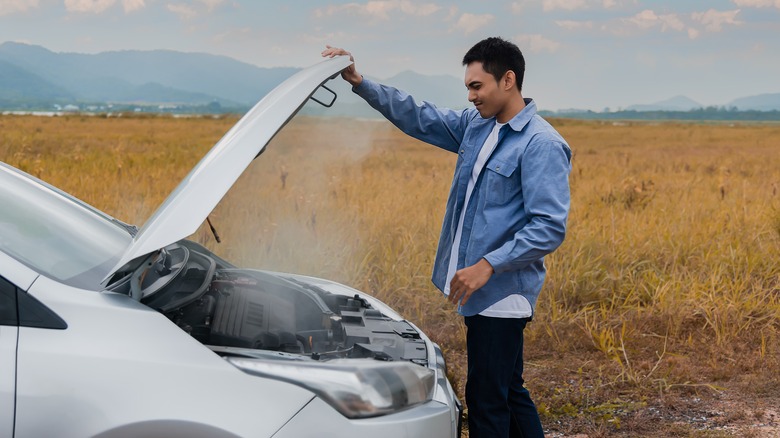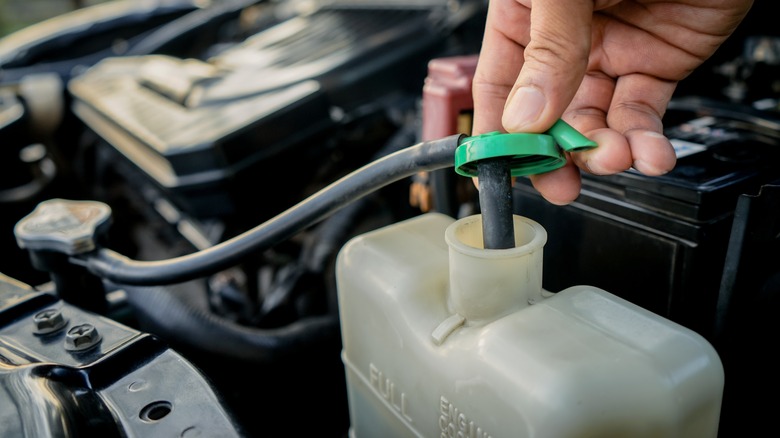Does Your Car Overheat When Idling? This Might Be The Reason Why
It's easy to assume overheating is a result of long road trips or summer heatwaves, but when your engine gets too hot while idling, it's usually a sign of something deeper that needs immediate attention. When you're cruising at high speeds, the air flows naturally through the grille to help the radiator keep the engine cool, but a stationary car relies entirely on its cooling system to regulate engine temperature. If any part of that system is faulty, it makes your car vulnerable to heat buildup.
One of the most common failure points in the cooling system is the electric radiator fan. At low speeds or when the vehicle is stationary, this fan is the primary mechanism drawing air through the radiator to keep temperatures in check. If it fails, whether due to a burned-out motor, faulty relay, or a bad engine temperature sensor, the system loses its ability to cool effectively. Another likely culprit is the water pump. Its job is to push coolant through the engine, allowing heat to transfer away from high-stress areas like the cylinder head and engine block. If the pump begins to fail, whether due to internal wear or bearing damage, coolant circulation can drop off, leading to rising temperatures.
The thermostat can also throw off this balance. If it becomes stuck in the closed position, it blocks coolant from reaching the radiator entirely, cutting off the system's ability to regulate heat. Low, degraded, or contaminated coolant can also be a factor as it can't absorb and dissipate heat properly. Coolant that hasn't been changed in years or is mixed incorrectly can also dramatically reduce the system's efficiency.
Why you shouldn't ignore your car overheating when idling
An overheating engine doesn't just leave you stuck in traffic with the A/C off. What starts as an inconvenience can quickly spiral into far more serious mechanical problems, some of which might not show up until much later. When heat builds up and lingers, internal components expand beyond their tolerance, and that stress doesn't go away once the temperature drops. Repeated overheating can deform cylinder heads, crack engine parts, and deteriorate head gaskets.
In fact, overheating due to engine cooling system failures accounts for 11% of serious roadside breakdowns requiring a tow, and repair costs can quickly escalate. A failed head gasket alone can cost anywhere from $1,000 to $3,000.
It can also damage the catalytic converter, an essential emissions filter that can cost between $200 and $2,500 to replace, excluding the cost of labor, inspection, towing, or any downtime associated with an immobile vehicle. Addressing the source of this issue promptly, especially when it only appears during idling, can make all the difference in keeping your car on the road and your budget intact. Acting early is rarely convenient, but it's almost always cheaper.
Simple fixes and smart checks for when you're stranded
Most cases of overheating while idling can be fixed with some basic checks and routine maintenance. You'll want to start with the coolant: When the engine is completely cool, open the hood and locate the coolant reservoir, which is usually a translucent plastic tank near the radiator. The tank should have "min" and "max" markings on the side. If the coolant level is below the minimum, top it up with the correct coolant or antifreeze mix that your vehicle requires. If the level keeps dropping over time, it suggests a leak. At that point, a mechanic should inspect the system using a pressure test to find the source.
If the coolant looks oily or dirty, a full flush might be due. Clear out the old coolant by opening the drain cap at the bottom of the radiator, refill with fresh fluid, and run the engine with the car's heater on to remove trapped air, so it doesn't block the coolant flow.
Next, check the radiator fan operation by listening for it to start when your car is idle. If you don't hear a whirring sound, check the fuse box (usually under the hood or near the dashboard) for any blown fuses and have them replaced. If the fuses look fine, the issue perhaps lies in the fan motor or a bad temperature sensor, in which case it's better to get a professional diagnostic check. If it's potentially anything other than that, inspecting and replacing is best left to a repair shop since these parts like the water pump and temperature sensor would involve disassembling the engine.


